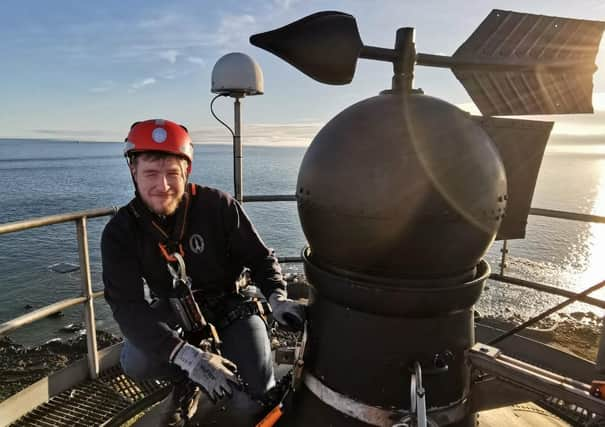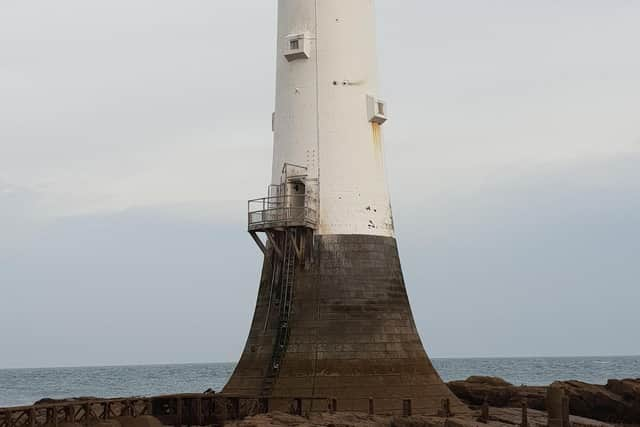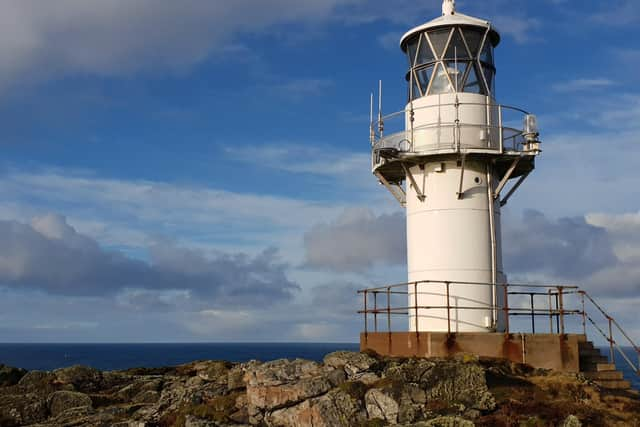The young man and the sea: the life of Scotland’s modern lighthouse keepers


Robert Stevenson, the Glasgow-born man who designed Scotland’s Bell Rock lighthouse and fathered an engineering dynasty, would have celebrated his 248th birthday next Monday on 8 June.
Decades after Scotland’s last true lighthouse keeper retired from his station, engineers from the Northern Lighthouse Board (NLB) still feel the waves pummel Bell Rock’s walls as they work to keep this wildest of outposts alight.
Advertisement
Hide AdAdvertisement
Hide AdElectrical technician Lachlan Greig, 23, is one of a new generation of apprentice engineers trained by the NLB especially for such a task.


Once scared of heights, he now clambers into helicopters and flies through 40 mile per hour winds to fix electronics, even scaling tower exteriors to help mend weather vanes and replace panes of glass hundreds of feet above the roaring sea.
Sometimes, he changes a hefty 400 watt lightbulb.
“Obviously there are no keepers anymore, but we are the closest thing to it. Every time you walk up the stairs or see the old clockwork kit, you feel a connection to the people and have to wonder about those who spent weeks or months of their lives there,” he says.
During a recent three-night stay on Bell Rock – the kind of rare pillar lighthouse built on reefs or skerries with the sea thrashing all sides – he found he was the perfect height to tuck into the old curved wooden bunk beds.


He says: “It was very relaxing with a little heater in the room, the window open and the sound of the sea and the engine way below.
“It’s probably the best night’s sleep I’ve ever had.”
Still essential
The NLB is responsible for 206 lighthouses across Scotland and the Isle of Man, working with Irish Lights and the English lighthouse authority Trinity House to illuminate seafarers’ journeys.
It regularly assesses which lights should shine further or brighter as shipping patterns change, and recently installed a new light on the Corran Narrows near Fort William to guide in growing numbers of cruise ships.
Despite the widespread use of GPS, lights remain a crucial part of maritime navigation.
Advertisement
Hide AdAdvertisement
Hide AdShipping lanes are increasingly busy: vessels are growing in number, with 90,000 boats in the world fleet in 2018, and their average size increasing by 20 per cent since 2011.
Other industries – like renewable wind power – also now compete for space at sea.
Yet GPS is imperfect: captains have been baffled when it misplaced their ship’s location and other recent incidents of GPS spoofing – where hackers confuse signals so ships do not know where they are – have worried security experts.
A recent report by European Space Agency Project Marrinav found that traditional lighthouses and buoys remained a necessary part of navigation systems.
NLB CEO Mike Bullock says: “Taking away that visual reference point would be like taking the kerb stones and road signs away from drivers.
“Our motto is For the Safety of All. Whilst a supertanker might have all the GPS equipment in the world, a guy in a small creel boat certainly won’t.”
Old dogs and new tricks
Funded by light dues – a tax ships pay for the service – the NLB employs 180 staff and, since launching an apprenticeship scheme in 2017, four trainees.
They are the keepers of lighthouses’ history, as well as their brilliance.
Advertisement
Hide AdAdvertisement
Hide AdFormer Royal Navy Commodore Bullock says: “We all benefit from it – technically and socially.
“You’ve got 18-20 year olds coming in with people who have been at sea for 40 years.
“It really perks up the old dogs.”
Greig was one of the first to join: inspired by his love of birdwatching and memories of childhood holidays on Tiree as much as his practical nous.
“I remember as a kid looking out at Skerryvore from Hynish seeing it flashing. Now I am seeing it from the other side,” he says.
Over the past three years Greig, who recently completed his apprentice qualifications but has one year of the scheme left, has visited around 50 of Scotland’s 206 lighthouses.
Most visits were planned maintenance, but occasionally a light went out and needed urgent repair.
As an apprentice, he is too junior to be on a regional rota of on-call engineers himself, but having helped respond to a few breakdowns, he admits looking forward to the responsibility.
“I might start Munro bagging – the list of people who’ve been up all of them and every lighthouse must be quite small. It could be my claim to fame,” he says.
Advertisement
Hide AdAdvertisement
Hide AdSome lighthouses require more attention than others, with engineers returning more frequently to coax older equipment.
Many of the most northerly solar-powered beacons also struggle in the depths of winter when their light is needed most but they don’t get enough sunshine.
Engineers are dispatched to turn on power-boosting generators, often taking boat trips to bleak locations on seas that churn even the most settled of stomachs.
From a vantage point on Stroma off the coast of John O’Groats, Greig watched tankers struggle in the infamous winter waters of the Pentland Firth.
“If you’re a little boat, you’ve got to hit it at slack water because if the tide hits the wind it creates waves that are just permanently there. It’s mental.”
Beautiful wilderness
Yet with the wildness comes the magic.
On a January trip to Haskier and the Monarch Isles in the Outer Hebrides, Greig was battered by a winter snow-storm, only for it to give way to bright sunshine, illuminating the white sand and brilliant blue of the sea. “The wind was so strong that the weather went past me. It was one of the most beautiful places I have ever been,” he says.
Whilst repairing sites, he’s encountered otters and countless porpoises that chased alongside boats. He followed a Minke whale through the sound of Skye and was tailed by a Golden Eagle as he scaled a cliff on Harris’ west coast.
Dolphins are so common that it became a running joke amongst the engineers to spot them within minutes of reaching a lighthouse’s top.
Advertisement
Hide AdAdvertisement
Hide AdAt times, the full-time residents of these remote spots can get in the way.
“Seals are actually a real nuisance in our job,” he laughs.
The inevitably exposed location of the lighthouses also posed other, less obvious, hurdles. Padlocks on lighthouse doors – arguably redundant in such isolated spots – rust shut in the months between engineer visits.
Greig admits that he is now a deft hand at breaking them open.
“If you’re three blokes who’ve been helicoptered out to an island in the middle of the Atlantic and you can’t open the door open because the padlock is a rusty mess it would be a bit embarrassing.
“At least I’ve got a side job if things get tough,” he jokes.
According to Historic Environment Scotland, 150 of Scotland’s lighthouses are currently protected for their special architectural or historic interest.
As part of its Year of Coasts and Waters 2020, HES is currently assessing whether others should be granted the same listed status.
Advertisement
Hide AdAdvertisement
Hide AdBullock says: “Some of these lighthouses have been doing exactly the same job for 200 plus years. They have new equipment but the basic task of protecting mariners stays exactly the same.
“We are just their custodians for a moment in time.”
Comments
Want to join the conversation? Please or to comment on this article.